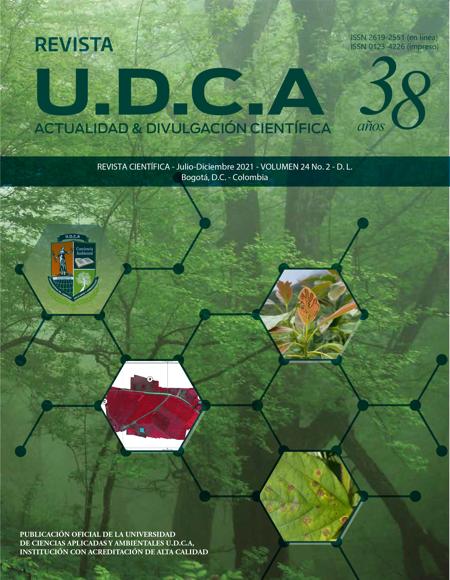Indicadores de estabilidad aeróbica en ensilajes de la mezcla Tithonia diversifolia/Pennisetum purpureum enriquecidos con Lactobacillus
Indicators of aerobic stability in silages of the mixture Tithonia.diversifolia/Pennisetum purpureum enriched with Lactobacillus
Contenido principal del artículo
Resumen
En épocas de escasez, los ganaderos recurren a conservar el alimento mediante procesos de fermentación anaeróbica, conocidos como ensilajes. Una vez que el silo es abierto, el sustrato resulta aeróbicamente estable, cuando, al momento de la apertura, conserva su integridad nutricional. Esto es el resultado de un ambiente ácido que restringe los efectos deletéreos de la acción de microrganismos patógenos, expresado en indicadores de estabilidad a la exposición aeróbica. Uno de los problemas empíricos que enfrenta el productor es resolver la pregunta de cómo evitar el deterioro del ensilaje, una vez es abierto, por lo cual, esta investigación apunta a la resistencia en el periodo de exposición aeróbica (PEA) de un ensilaje de Pennisetum purpureum (PP), con diferentes niveles de sustitución de Tithonia diversifolia (TD). El estudio, se adelantó en el Centro Internacional de Agricultura Tropical en Colombia. Con un ensilaje de 90 días de fermentación, se realizó una prueba de estabilidad aeróbica de siete días, usando ensilajes de un kilogramo, a diferentes proporciones (%) de TD/PP: 100/0, 67/33, 33/67 y 0/100, enriquecidos con dos aditivos basados en Lactobacillus. Se midió el cambio de la materia seca, temperatura y el pH, encontrándose una estabilidad a la exposición aeróbica. El papel de TD es notable, una vez que el ensilado entra en el PEA, debido a la capacidad tampón que amortigua el cambio de pH, una vez que se abre el silo, generando mayor estabilidad aeróbica.
Palabras clave:
Descargas
Datos de publicación
Perfil evaluadores/as N/D
Declaraciones de autoría
- Sociedad académica
- Universidad de Ciencias Aplicadas UDCA
- Editorial
- Universidad de Ciencias Aplicadas y Ambientales U.D.C.A
Detalles del artículo
Referencias (VER)
ASSOCIATION OF OFFICIAL ANALYTICAL CHEMISTS, AOAC. 1990. Official Methods of Analysis. Washington, D.C.
ÁVILA, C.L.S.; PINTO, J.C.; FIGUEREIDO, H.C.P.; SCHWANT, R.F. 2009. Effects of an indigenous and a commercial Lactobacillus buchneri strain on quality of sugar care silage. The Journal of the British Grassland Society. Grass and Forage Science. 64(4):384-399.
https://doi.org/10.1111/j.1365-2494.2009.00703.x
BERNARDES, T.F.; NUSSIO, L.G.; DO AMARAL, R.C. 2012. Top spoilage losses in maize silage sealed with plastic films with different permeabilities to oxygen. Grass Forage Sci. 67:34–42.
https://doi.org/10.1111/j.1365-2494.2011.00823.x
BORREANI, G.; TABACCO, E.; SCHMIDT, R.J.; HOLMES, B.J.; MUCK, R.E. 2018. Silage review: Factors affecting dry matter and quality losses in silages. Journal of Dairy Science. 101(5):3952-3979.
https://doi.org/10.3168/jds.2017-13837
DANNER, H.; HOLZER, M.; MAYRJUBER, E.; BRAUN, R. 2003. Acetic Acid increases stability of silage under aerobic conditions. Applied and Environmental Microbiology. 691:562-567.
https://doi.org/10.1128/AEM.69.1.562-567.2003
DI RIENZO, J.A.; CASANOVES, F.; BALZARINI, M.G.; GONZÁLEZ, L.; TABLADA, M.; ROBLEDO, C.W. 2008. InfoStat, versión 2008, Grupo InfoStat, FCA, Universidad Nacional de Córdoba, Argentina.
ESPINOZA, I.; MONTENEGRO, B.; RIVAS, J.; ROMERO, M.; GARCIA, A.; MARTINEZ, A. 2017. Características microbianas, estabilidad aeróbica y cinética de degradación ruminal del ensilado de pasto saboya (Megathyrsus maximus) con niveles crecientes de cáscara de maracuyá (Passiflora edulis). Revista Científica. 27(4):241-248.
GERLACHA, K.; ROß, F.; WEIß, K.; BÜSCHERB, W.; SÜDEKUM, K.H. 2014. Aerobic exposure of grass silages and its impact on dry matter intake and preference by goats. Small Ruminant Research. 117(2-3):131-141.
https://doi.org/10.1016/j.smallrumres.2013.12.033
HEINRITZ, S.; MARTENS, S.D.; AVILA, P.; HOEDTKE, S. 2012. The effect of inoculant and sucrose addition on the silage quality of tropical forage legumes with varying ensilability. Animal Feed Science and Technology. 174(3-4):201-210.
https://doi.org/10.1016/j.anifeedsci.2012.03.017
HOEDTKE, S.; ZEYNER, A. 2011. Comparative evaluation of laboratory-scale silages using standard glass jar silages or vacuum-packed model silages. Journal of the Science of Food and Agriculture. 91(5):841-849.
https://doi.org/10.1002/jsfa.4255
HOLDRIDGE, L.R. 2000. Ecología basada en zonas de vida. Instituto Interamericano de Cooperación para la Agricultura (Costa Rica). p.215
HOLGUÍN, V.A.; CUCHILLO-HILARIO, M.; MAZABEL-PARRA, J.; MARTENS, S. 2018. In-vitro assessment for ensilabillity of Tithonia diversifolia alone or with Pennisetum purpureum using epiphytic lactic acid bacteria strains as inocula. Acta Scientiarum. Animal Sciences. 40:e37940
https://doi.org/10.4025/actascianimsci.v40i1.37940
HONIG, H. 1990. Evaluation of aerobic stability. Proceedings of the EUROBAC Conference, 12-16 August 1986, Uppsala. GrovFoder Grass and Forage Reports. Spec. 3:76-82.
HONIG, H.; WOOLFORD, M.K. 1980. Changes in silage on exposure to air. En: Thomas, C. (Ed.). Forage Conservation in the 80s. British Grassland Society (Hurley, Berkshire, UK).
JONES, C.M.; HEINRICHS, A.J.; ROTH, G.W.; ISHER, V.A. 2004. From harvest to feed: Understanding silage management. Pennsylvania State University. College of Agricultural Sciences (Pennsylvania). 36p.
KUNG JR., L.; SHAVER, R.D.; GRANT, R.J.; SCHMIDT, R.J. 2018. Silage review: Interpretation of chemical, microbial, and organoleptic components of silages. Journal of Dairy Science. 101(5):4020-4033.
https://doi.org/10.3168/jds.2017-13909
MARTENS, S.D.; HOEDTKE, S.; AVILA, P.; HEINRITZ, S.N.; ZEYNER, A. 2014. Effect of ensiling treatment on secondary compounds and amino acid profile of tropical forage legumes, and implications for their pig feeding potential. Journal of the Science of Food and Agriculture, 94(6):1107-1115.
https://doi.org/10.1002/jsfa.6375
MENDIETA-ARAICA B.; SPÖRNDLY, E.; REYES-SÁNCHEZ, N.; NORELL, L.; SPÖRNDLY, R. 2009. Silage quality when Moringa oleifera is ensiled in mixtures with Elephant grass, sugar cane and molasses. Grass and Forage Science. 64(4):364-373.
https://doi.org/10.1111/j.1365-2494.2009.00701.x
NAVAS, J.A.; MORALES, D.A. 2016. Libro de texto de microbiología pecuaria. Universidad Nacional Agraria (Nicaragua). 128p.
NIELSEN, S. 1994. Introduction to the Chemical Analysis of foods. Ed. Jones and Bartlett Piblishers. (U.S.A.). 530p.
OTTHUIS, W.; LUO, J.; BERGVELD, P. 1994. Characterization of proteins by means of their buffering capacity, measured with an ISFET- based colorimetric sensor-actuator system. Biosensors and bioelectronics. 9(9-10):743-751.
https://doi.org/10.1016/0956-5663(94)80073-1
OUDE, S.J.W.H.; DRIEHUIS, F.; GOTTSCHAL, J.C.; SPOELSTRA, S.F. 1999. Estudio 2.0 - Los procesos de fermentación del ensilaje y su manipulación. In: Mannetje, L.T. (ed.). Uso del Ensilaje en el Trópico Privilegiando Opciones para Pequeños Campesinos. N°. 161 FAO, Roma. Disponible desde Internet en: http://www.fao.org/3/X8486S/x8486s04.htm#bm04 (con acceso el 15/01/2019)
PAHLOW, G.; MUCK, R.E.; DRIEHUIS, F.; OUDE ELFERINK, S.J.W.H.; SPOELSTRA, S.F. 2003. Microbiology of Ensiling. In: Buxton, D.R.; Muck, R.E.; Harrison, J.H. (eds.). Silage Science and Technology. American Society of Agronomy. 63p.
https://doi.org/10.2134/agronmonogr42.c2
SANTOS DA SILVA, W.; CARVALHO DOS SANTOS, T.M.; CAVALCANTI NETO, C.C.; FILHO ESPINDOLA, A.M.; MESQUITA DA SILVA, S.G.; NEVES FIGUEIREDO, A.; ARAÚJO DE MELO, B. 2014. Características y estabilidad aeróbica de ensilajes de caña de azúcar, tratada con urea, NaOH y maíz. Pastos y Forrajes. 37(2):241-247.
VAN SOEST, P.J.; WINE, R.H. 1967. Use of detergents in the analysis of fibrous feeds. Journal of Association of Official Analytical Chemists. 50(1):50-55.







